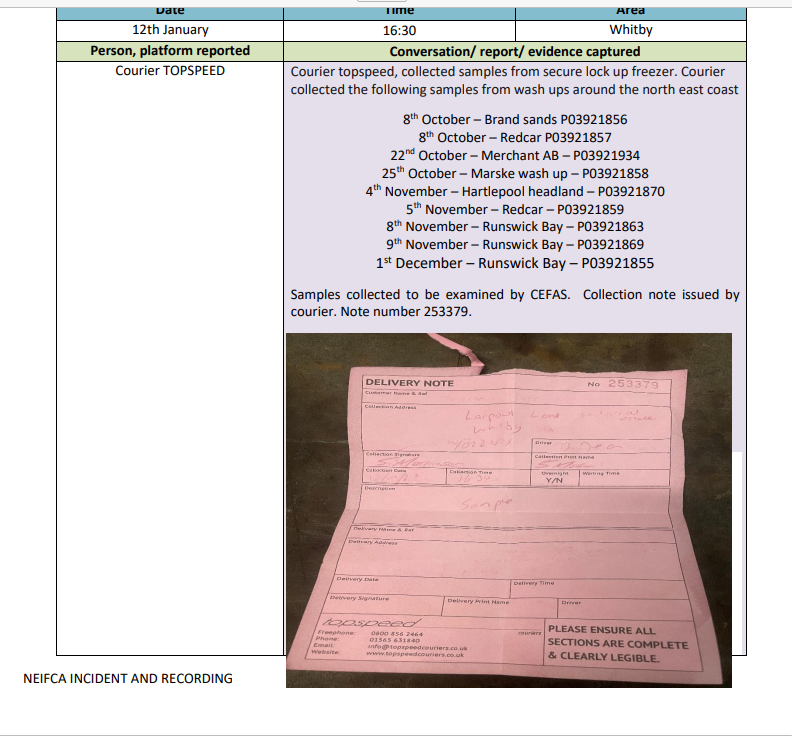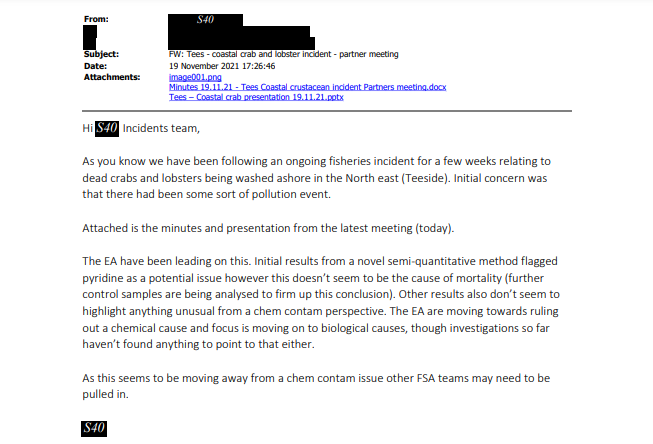Poison Earth
part 4:
Who Killed
the Octopus
at Runswick Bay?

Photo courtesy of Masaaki Komori on Unsplash
Scott Hunter
20 June 2023
October 2021 saw the mass die-off of crab and lobster in an area from Teesmouth to Whitby, which has had a devastating impact on the local fishing industry, and is the subject of ongoing controversy, not only among fishers and the general public across the Tees Valley, but hopefully also around the watercoolers of Defra’s various partner agencies where a number of reputations may have been tarnished by suspicion that the management of the catastrophe has been subject to political manipulation.
The crustacean die-off was followed by limited investigation, a hasty conclusion, and a lot of belligerence from various political figures both local and national. The matter has been declared closed a number of times. Yet it just won’t go away. There are too many loose ends. One of those loose ends concerns octopus.
While the crustacean die-off spiked in October 2021, and received widespread publicity, a month later hundreds of octopus were reported washed up at Runswick Bay, near Whitby, but this event received no media coverage. Within days further cephalopod die-off was being reported around Hartlepool, Seaham and South Shields. In response to the Runswick Bay die-off, officers from North East Inshore Fisheries and Conservation Authority (NEIFCA) took samples of octopus tissue and sent them to the Centre for the Environment, Fisheries, and Aquaculture Science (Cefas) for analysis.
We contacted Cefas to find out the results of that analysis. The response we got provides some insight into the handling of incident generally.
The investigation was initially led by the EA, but at the end of November 2021 it was handed over to Defra. Defra officially closed their investigation in March 2022. While the initial investigations had examined possible causes such as chemical pollution, sewage, and seismic activity, Defra shortly announced that they believed the cause was Harmful Algal Bloom (HAB). The possibility of it being due to HAB had not been considered while the EA was leading the investigation. Among emails we have seen from the various agencies involved in the investigation, another cause was proposed – a pathogen known as DSP. But that explanation never made the cut. Reasons unknown.
Reports of subsequent die-off of various species continued throughout 2022, all of which were dismissed by the Environment Agency (EA) as due to weather conditions. In October 2022, a parliamentary hearing recommended that competing explanations for the initial crustacean die-off be evaluated by an independent panel. When Defra convened its ‘Independent Panel’ to investigate ‘unusual mortality’ towards the end of that year, the later die-off was given short shrift. Except for the octopus.
With regard to the cephalopod die-off, the ’Independent Panel’ report repeated some of the speculation from EA officers about possible cause, one of which, alarmingly, was
“It is also possible that octopus may have died from eating contaminated crabs, or died of the same things as the crabs.”
It was only later that we learned that samples of octopus from Runswick Bay had been taken and sent for analysis (when we were shown records kept by NEIFCA). So why did the panel report only refer to speculative causes of death? We made a FOI request to Cefas to ask what the results of their analysis were. We will return to this shortly. But first, it is necessary to understand how the octopus die-off fits into the sequence of events in 2021 and 2022.
Following the initial crab die-off in October 2021, a small number of samples were sent by the Environment Agency (EA) to the National Laboratory Service for analysis. The results were returned on 5 November. In total, there were five samples from the affected area, and four control. These samples showed high concentrations of pyridine in the crab from the affected area and one from the control.
So, the sample was very small and the result not clear cut. It is also important to note that, at this point, the results of the tests were not made known, either to the fishers or to the public.
On the same day, Defra issued a press release stating the possibility of contamination as the cause of the die-off. This was followed, on 26 November, by a second press release, this time from the EA, stating that contamination had now been ruled out. The statement goes on,
“Sarah Jennings, Operations Manager from the Environment Agency, said:
“We understand how distressing this incident is for the local shellfish industry and for members of the public, so this investigation has been a top priority for Environment Agency and Cefas laboratories.”
Has been a top priority. Past tense.
Which may help to explain how the agencies involved dealt with what happened next.
The octopus die-off was first reported to NEIFCA on 29 November. Officers went to Runswick Bay on 1 December and collected a tissue sample, which, as is standard practice, was immediately frozen. It was dispatched to Cefas along with samples of other marine species, principally crab, but not until 12 January, six weeks later.


So, on to our FOI inquiry. Initially, Cefas denied all knowledge of the sample. When pressed, however, they found it after all and replied:
“After re-examining this request, we can confirm that a sample of octopus was transported from NE-IFCA to Cefas Weymouth. This sample was transported on a precautionary basis in case of future relevant analysis for food safety, disease or contaminants. However, ultimately no analytical work was conducted for this sample.”
Defra’s curiosity about the cause of the mortality both of crustaceans and cephalopods already extinguished. So, it’s starting to look as if the investigation actually ceased well before the official closure in March 2022.
By the end of January, the North East fishers had been told that if they wanted there to be further investigation into these events they would have to commission it themselves. DSP was forgotten and HAB was now the official explanation, despite the fact that it was highly suspect. End of. For the time being.
Unfortunately for Defra, the North East fishers did precisely what they had suggested and commissioned their own investigation, and the ‘algal bloom theory’ shortly had a rival – that the die-off was the result of pyridine contamination on a massive scale. Eventually this resulted in a parliamentary hearing of the EFRA Committee hearing, in October 2022. The outcome of this was that an ‘independent panel’ was set up to adjudicate. But it was set up by Defra, and with terms of reference set by Defra, and set a timetable by Defra. And it produced a report that was useful only to Defra. Which is why we put it in inverted commas.
The Defra ‘Independent Panel’ report rubbished ‘the algal bloom theory’. In its place, they speculated that the die-off may have been the result of a ‘novel pathogen’, hitherto unknown to science, of which more later. First, however, there remains the issue of their apparent indifference to the fate of the octopus.
Three questions arise in relation to the octopus. We sent these to Defra:
1. Why didn’t CEFAS analyze the octopus samples?
2. Did the ‘Independent Panel’ question whether or not these samples had been analyzed?
3. Does CEFAS plan to carry out tests on the octopus samples now?
We shortly received an email telling us that questions 1 and 3 were being answered by Cefas, who told us that “For question (2), we've advised that this be directed to the Office of the Chief Scientific Advisor who you should expect a separate response from”. It turns out, however, that the Chief Scientific Advisor didn’t want to talk about it. As regards questions 1and 3, Senior Adviser, Joe Perry told us:
“Question (1) - Our statutory role is to monitor for and control listed and emerging infectious diseases only. Principally it’s not appropriate to conduct histological analysis (analysis for signs of pathogenic and non-pathogenic disease) when material is frozen. More specifically however, as detailed in the FOI response you list, this sample was taken only on a precautionary basis. The number of dead and moribund crustaceans observed in Autumn 2021 was unusually high, and so it was appropriate to conduct histological analysis on these samples. By comparison, the number of dead and moribund cephalopods observed in Autumn 2021 was not high to the extent that it was considered appropriate to conduct histological analysis on cephalopod samples. Further, there are no listed diseases that would affect octopus.
“Question (3) - There are no plans at the time of writing to conduct any specific analysis on this sample.”
As Defra’s original explanation of the die-off has now been abandoned, it may come as a surprise to readers to find that Cefas has no plans to examine the sample it is holding. Isn’t there a novel pathogen out there that needs to be identified?
One of those questions concerns his reference to histology. Histological analysis cannot be undertaken on frozen samples. But such analysis would only be undertaken to search for pathogens, i.e. Disease. The fact that the samples are frozen does not prevent them being analysed for evidence of contamination, which is what happened with the samples analysed by the National Laboratory Service (NLS) in November 2021 where elevated concentrations of pyridine were found.
Furthermore, if Cefas’ role is to only to commission or undertake investigation into pathogens, why were they sent the samples in the first place? Why not sent them to the EA? Presumably NEIFCA officers are familiar with who does what.
A second question relates to the size of the die-off. The crab die-off ran into thousands; the octopus in hundreds. Joe Perry’s assertion here that the size of the die-off informed the decision to undertake no analysis makes sense only if the two events are treated as being unrelated. However, given that octopus feed on crab, there is a common-sense association between the two.
Is Cefas now looking for signs of the novel pathogen indicated in the ‘independent panel’ report? No. For two reasons. One is that they can’t because it is difficult to do the necessary work when the samples are frozen. The other is because the ascription of the die-off to a novel pathogen is not based on direct, scientific evidence but only on statistical probability. The ‘Independent Panel’ report states:
“… the panel concluded that disease was about as likely as not (33 to 66% probability) to be the cause of the mass mortalities reported in the north-east of England”
We sent a copy of an earlier draft of this article to a researcher, Simon Gibbon. One of his comments was “CEFAS is internationally recognised as being experts at detecting novel pathogens, so if they can't find one, there probably isn't one. And why haven't they been tasked to look?” [Or, to put it another way, the result of the ‘independent panel’ inquiry was to paralyse further investigation]
To return to the fate of the octopus, it is clear that, by 12 January 2022, no one was interested in analysing the sample. We have attempted therefore to track the events of November 2021 to find out how the active investigation moved from obtaining evidence of pyridine contamination on 5 November to the issuing of a press release by the Environment Agency on 26 November stating that contamination had been ruled out as a possible cause of the mortality.
Some relevant information is contained in FOI disclosures from the Food Standards Agency. The first is an email from 9 November about the EA finding high levels of pyridine in crab:

(where RA is risk assessment and Rfd is Reference Dose) The email reports, on the one hand, high levels of pyridine in crab meat, and ’significant uncertainty around the toxicity of pyridine’, on the other. But it is not referencing the NLS analysis posted on 5 November. By 19 November, however, without investigation into the toxicity of pyridine, the EA doubted it having a key role in the die-off:

So, “Initial results from a novel semi-quantitative method flagged pyridine as a potential issue however this doesn’t seem to be the cause of mortality (further control samples are being analysed to firm up this conclusion”). This is an astonishing reverse. In order to establish that pyridine was not the cause of the mortality, they would need to know the toxicity of pyridine to crab. This was not known in November 2021. In fact, this was what Dr Gary Caldwell of Newcastle University undertook in 2022, in research commissioned by the fishers, the results of which we submitted to the EFRA committee in October 2022.
It appears that the EA set out to eliminate pyridine by further testing of control samples – i.e. if enough control samples from around the country showed high concentrations of the toxin, then the results from Teesside would no longer be anomalous.
However, the FSA email seems to indicate that by 19 November this sampling had not been undertaken. If they were, then no results analysis has appeared in the public domain. Moreover, were such evidence made available to the Defra ‘independent panel’ they would presumably have mentioned in their January 2023 report. Yet, seven days after the FSA email, the EA issued a press release stating that chemical contamination had been eliminated as a potential cause of the mortality. We have now written to the EA and the Food Standards Agency to ask them to supply the evidence of that sampling. Without it, we will be forced to conclude that the EA denied that pyridine was the agent without evidence.
Or, in other words, were they put under pressure to steer the investigation away from chemical cause for the incident?
It should be highlighted, moreover, that in mid-November 2021, pyridine contamination was not one among a number of competing explanations for the die-off; it was the only one. As the FSA email clearly states, no biological cause had been identified at that point, and therefore the 26 November press release is effectively a statement concluding that the cause of the incident had been investigated and no cause had been found.
On the evidence that we currently have to hand, we must conclude that investigation into marine mortality in and around Tees Bay ceased on or before 26 November 2021, scant seven weeks after mass crustacean die-off was first reported. Of the possible causes of the event only the possibility of pyridine contamination was supported by evidence. That does not mean to say that the evidence was conclusive, but simply that no other possible cause had been identified. And yet the investigation was closed down, long before this was officially announced.
Having investigated the timeline of the investigation and found it to be remarkably short, we are led inevitably to conclude that the discovery of pyridine raised alarm bells somewhere in government and led to the EA being warned off. There were three probable sources of pyridine – Vertellus, who imported it to their Billingham plant, Teesworks, where unknown quantities of it remain underground, and the sandbar at Teesmouth that may have contained historic deposits and which was dredged in late September 2021.
Had the source been a spillage at Vertellus, the pyridine would have been in the water column and the EA quickly established that it was not. Much has been said about dredging, and while dredging is generally hazardous to marine life because of the sediment plume that is raised and which remains suspended in the water column for some time before settling back on the sea/river bed. The problem with attributing the event to maintenance dredging is that this is a procedure carried out regularly, and there have been no previous incidents of this kind.
That leaves Teesworks, the land of secrets, closed to the outside world, accessible only to agencies such as EA and HSE. There is a deal of suspicion that both health and safety standards and environmental protection on the site are less than robust. This leads us to question just how vigorous these two agencies have been in ensuring that appropriate standards during construction and demolition are being met. To that end we have now written to the EA to ask for details of certain investigations they have carried out on the site. We are certain that the EA will provide us with the information we have requested, but that, in fact is not quite enough. A much more wide-ranging investigation is needed, and that would require an official inquiry.
[It is worth noting here that the Defra ‘independent panel’ was tasked with considering the potential role of dredging in the die-off, but not Teesworks]
An ’independent’ inquiry into Teesworks, organised by the Department for Levelling Up, Housing and Communities, will being shortly, an inquiry that will not investigate its environmental and safety record. Which brings us to the heart of the issue of Teesworks, that a full investigation into the activities of those who oversee the project would have more tentacles than an octopus.
The (allegedly) hundreds of octopus that washed up on the beach at Runswick Bay have already been consigned to the lumber room of history by Defra’s partner agencies. Teesworks must not be subject to the same incuriosity.
